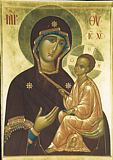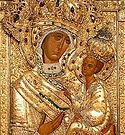

| Previous day | Next day |
| Old Style
June 26
|
Tuesday |
New Style
July 9
|
|
4th Week after Pentecost.
Tone 2.
Fast of the Holy Apostles. |
Wine and oil allowed.
|
![]() Appearance of the Tikhvin Icon of the Most Holy Theotokos (1383).
Appearance of the Tikhvin Icon of the Most Holy Theotokos (1383). ![]() St. David of Thessalonica (540).
St. David of Thessalonica (540).
St. John, bishop of Gothia in the Crimea (ca. 800). St. Dionysius, archbishop of Suzdal (1385). Uncovering of the relics of St. Tikhon of Lukhov (1569). Translation of the relics of St. Nilus of Stolobny (1995).
Icon of the Most Holy Theotokos “Of Lydda” (1st c.) Icon of the Mother of God “Neamts” (1399). and “Of the Seven Lakes” (Kazan) (17th c.).
St. Brannock (Brynach) of Braunton, England (6th c.). Martyr Pelagius of Cordoba (925). New Martyr David of St. Anne’s Skete, Mt. Athos, at Thessalonica (1813).
Thoughts for Each Day of the Year
According to the Daily Church Readings from the Word of God
By St. Theophan the Recluse

Tuesday. [Rom. 10:11-11:2; Matt. 11:16-20]
The Lord says that we, not heading the Gospels, are like those to whom merry songs are sung, but they do not dance; sad songs are sung, and they do not cry. You cannot do anything with them. We are promised the heavenly Kingdom, most bright and joyous, but we are unmoved, as if they were not speaking to us. We are threatened with impartial judgment and unending torments, but we are not alarmed; it is as if we do not hear. Downtrodden, we have lost all feeling of true self-preservation. We move as ones being led directly to destruction, and haven’t a care for our destiny. We have lost heart, given ourselves over to carelessness—what will be, will be! Look at our state! Isn’t this why suicides are so frequent? It is the fruit of modern teachings and views on man and his [in]significance! There is progress for you! There is enlightenment! It would be better to be totally ignorant, but save your soul with fear of God, than, having attained the title of an enlightened person, to perish unto the ages, never thinking your entire life about what will happen after death. Not a single jot shall pass from the word of God, which describes both the heavenly kingdom and hell—all will be as it is written. Take this to heart, everyone, as something which touches you personally; and take care for yourself, with all your strength, and as long as time remains.
Articles
 Appearance of the Tikhvin Icon of the Mother of God |
 St David of Thessaloniki |
 St Dionysius the Archbishop of Suzdal |
 Venerable Tikhon of Luchov, KostromaSt Tikhon of Lukh, and Kostroma (in the world Timothy), was born within the bounds of the Lithuanian princedom and was in military service there. |
 Icon of the Mother of God “Neamts” |
 Icon of the Mother of God of Seven LakesThe “Seven Lakes” Icon of the Most Holy Theotokos shone forth with many miracles in the seventeenth century in the area of Kazan. |




